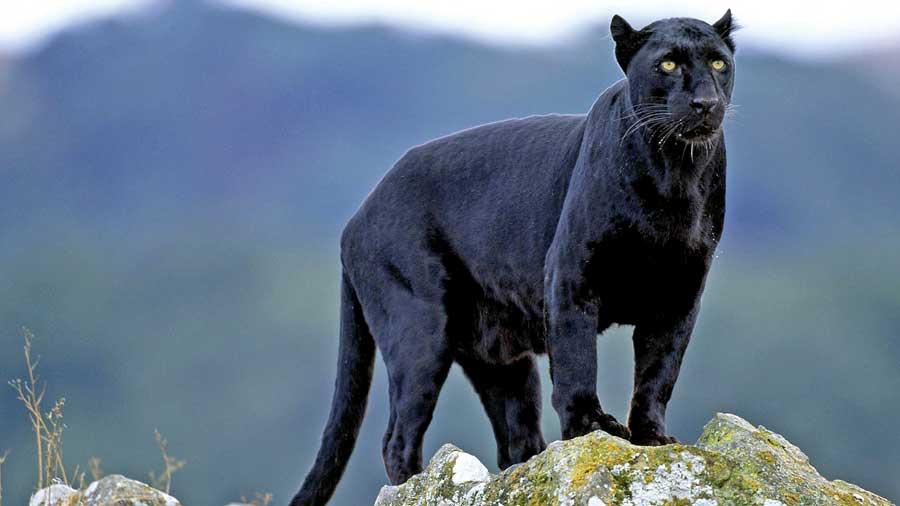29 Jan 2020 - {{hitsCtrl.values.hits}}

- Gradual depletion and fragmentation of habitat most imminent threats
- Leopard is an apex predator that has made SL a top tourist attraction
- Three leopards killed this month; 385 elephants killed in 2019
- Leopard ‘mistakenly’ termed aggressive at diverse situations in Kumana and Yala
- One does not have to go far to learn sustainability
There is drama surrounding the leopard these days; the black leopard in peak wilderness and released leopard in Wilpattu. This article neither intends analysing the wildlife cum conservation issue surrounding the leopard nor points fingers at anyone who did what they did not in the right way. The purpose in the ‘sustainable nation’ column is to examine how sustainably we march forward as a nation in handling our issues. The recent news about the leopard will be discussed in that light. 
Speaking to Daily Mirror about large mammals in Sri Lanka, Dr. Sumith Pilapitiya, former lead environmental specialist of the South Asian region of World Bank and former Director-General of the Wildlife and Conservation Department, said “Sri Lanka is famous for its charismatic species such as the leopard, elephant, bear and whale. However, these species are under threat. 385 elephants were killed in 2019 and we had three leopards that were killed during the first 10 days of this year – all this by man.
There is a grave danger as leopards are being killed for illegal wildlife trade. This is reflected by the manner in which the leopard near Uda Walawe was mutilated. In some countries, leopard parts are being sold as those of tigers for medicinal purposes. This trend is extremely dangerous. Although public awareness on the value of these species to Sri Lanka is vital, this subject area is largely neglected. It is incumbent on the Wildlife and Conservation Department and all of us as citizens of this country to do everything we could to protect these species.”
Presently an independent researcher, Pilapitiya seemed to have concerns over the points raised by Dr. Enoka Kudawidanage, Head of the Sabaragamuwa UniversityNatural Resources Department.
"There is a grave danger as leopards are being killed for illegal wildlife trade. This is reflected by the manner in which the leopard near Uda Walawe was mutilated - Dr. Sumith Pilapitiya"
“The leopard in Sri Lanka is of paramount importance. It is an apex predator, charismatic species and the leopard has massively contributed in making Sri Lanka a top tourist destination in the world in terms of high visibility,” said scientist Kudawidanage with reference to the time that one would spend either in India or Africa to sight a leopard being much more in comparison to that in Sri Lanka.
Having established the importance of the iconic leopard to Sri Lanka and her economy; Anjalie Watson, Ecologist and Managing Trustee of the Wilderness and Wildlife Conservation
Trust, Dr. S. Mittapala, Conservation Biologist and Dr. Andrew Kittle, Lead Scientist of the Wilderness and Wildlife Conservation Trust were inquired upon the threats encountered by this charismatic species.
“Loss of habitat,” said all three, unanimously. According to these three scientists who have spent long years researching the leopard and issues surrounding it, “gradual depletion and fragmentation of habitat” is the most imminent threat.
“Snaring, poisoning and other forms of human intervention are grave, no doubt!” said Watson. “However, the most serious issue is habitat loss which has been happening in Sri Lanka due to haphazard development.”
Kittle elaborated that issues encountered by the leopard were different from one location to the other. Hence, each province has a different concern and different locations even within the same province have identical issues. For instance, in central highlands, snaring is rampant. It is known that the leopard gets incidentally trapped on a snare meant for wild boar, deer or hare.
In the dry zone, the leopard is considered as an impediment to efficient cattle raring. Incidents have been reported where the farmer ignorantly perceived the leopard to be responsible for lost cattle, hence poising this charismatic species was a retaliatory measure. However, the more realistic causes for such cattle loss could be theft or disease.
The North and East of Sri Lanka have much resettlement taking place and the leopard population seems to be affected by this. According to Watson and Kittle, though there is no researched data on leopard population prior to, during and post conflict in N-E, one would certainly decipher any wildlife population being affected with rapid and sudden development taking place, unless measures are adopted to ascertain wildlife feasibility of such development projects.
"The leopard in Sri Lanka is of paramount importance. It has massively contributed in making Sri Lanka a top tourist destination in the world in terms of high visibility - Dr. Enoka Kudawidanage"
Kudawidanage underscored diverse situations in the recent years where the leopard was mistakenly termed aggressive. A safari jeep was attacked by a leopard in Kumana while it was sleeping under a tree. This was a mere hunting act by the leopard. It did not pursue and hunt a human being. Sleeping under a tree in the midst of a forest would certainly make an easy prey for a predator.
In Yala, outside Galge, a pregnant woman had couched under a bush in the ticket to urinate. The leopard attack that took place here is again an incident of the human intervening into the forest and making her succumb to a vulnerable position to be prey to a hunter mammal.
Again in Kumana, a group of people thronged to watch a leopard feeding on a dog. The leopard attacked one of the men who so gathered. It is the primary nature of any beast to feel threatened if flocked around and observed when it was feeding itself. It is perceived as a “would-be” attempt to grab its prey and the animal would get ferocious and attack as a mean of defence.
" For the black leopard controversy, Sooriyabandara said there was a high tendency for the leopard to not be another sub species but a morphological variant of the same. Many researchers expressed the same opinion"
The central hills have darker stories to narrate about leopard being poisoned and even stabbed on the eye. The latest dark day occurred around the corner at Wilpattu. Wildlife Department Director-General Chandana Sooriyabandara said it was a test done to observe if a leopard that was abandoned as a cub would be reintroduced to the wild. Sooriyabandara explained that this was an attempt done bona fide in the interest of wildlife and certainly unforeseen situations such as this would occur in a pilot project of this nature.
What matters most is that no casualty resulted in this effort and as far as lessons could be learnt from such unforeseen situations, Sri Lanka can still own to be moving on the sustainable path.
For the black leopard controversy, Sooriyabandara said there was a high tendency for the leopard to not be another sub species but a morphological variant of the same. Many researchers expressed the same opinion.
Viraj Senewiratne, animal lover and wildlife enthusiast who frequented Wilpattu for the last four decades, spoke about the onus of responsibility. When an incident of this nature takes place, one needs to be vigilant in assuming responsibility. “One cannot just talk about an incident and leave it aside,” said Senewiratne, who himself engaged in wildlife writing and photography, honouring the passion for the leopard.
"The most serious issue is habitat loss which has been happening in Sri Lanka due to haphazard development - Anjalie Watson"
Although one would conveniently believe or would like to believe that the leopard had been caught on a snare intended for another protected wildlife species such as wild boar or deer, Kudawidanage said situations in which such leopards caught by snares had their paws cut off, teeth extracted and skin peeled. If the said snares were incidental, why were the body parts missing in the leopard carcass?
“Leopard trade would come into light at such doubt and the superstitious belief on black magic has its own part to blame for these missing body parts,” he said.
To be sustainable as a nation, one would necessarily evaluate the prevailing situation, which is being done by experts. What is next? When threats are identified and dark days seen through, unless one carves out solutions, and practical solutions out of such evaluation, would there be any point?
Kittle said Sri Lanka still stood at a very good position in comparison to the international landscape where most countries needed to adopt re-wilding policies in the context of large herbivores. “That is only if we maintain it,” added Mittapala and Watson who feared the way habitat loss takes place now, Sri Lanka may soon lose that “good” position. According to them, Sri Lanka already has had a sustainable approach in the past.
“What about home and forest gardens?” asked Watson. “One does not have to go far to learn sustainability,” said the dedicated researcher who elaborated that these provided transitional space to the wildlife to move. In equal measure, preserving ridge lines is a must. They function as movement corridors. The ridge lines serve the dual role in facilitating the forest in weather control by retaining the ground and rain water in its catchment area.
All experts spoken to illustrated the importance of serious ecological consideration of improving leopard habitat and its habitat requirements, changing the mindset of the local community to better understand the realistic position of the leopard and its behaviour, conservation-friendly policymaking, enforcement of such policy, strict legal enforcement on illegal activities and accumulating scientific information of invaluable research and field data by different scientists would make a starting point in sustainability.
" In central highlands, snaring is rampant. It is known that the leopard gets incidentally trapped on a snare meant for wild boar, deer or hare - Dr. Andrew Kittle"
Development certainly is a must. It is the call of a nation to opt for sustainable development as opposed to haphazard development. When an incident as it did occur in Wilpattu, there is a trend to talk about it. However, the hype wears out after some time. Then comes up another; that too would be spoken of for a while. Likewise, one issue would be moved on to another. Attention would be given, sometimes undue or extravagant, contributing negatively rather than positively towards sustainability. For instance, as Watson and Kittle said, snaring and poisoning were no doubt serious issues, but they were no close when compared to the grave threat and serious issue of habitat loss.
Therefore, let the focus be on the bigger picture. We need the leopard. We need the human. We need all other living species. And we also need development. Let us, as an individual, carve out our own method and get together as a nation in balancing all these spheres positively and productively. That would be the best step we could take towards a sustainable nation.
The writer is a freelance lawyer and journalist. She can be contacted at
[email protected]

07 Jan 2025 7 hours ago
07 Jan 2025 7 hours ago
07 Jan 2025 8 hours ago
07 Jan 2025 07 Jan 2025
07 Jan 2025 07 Jan 2025